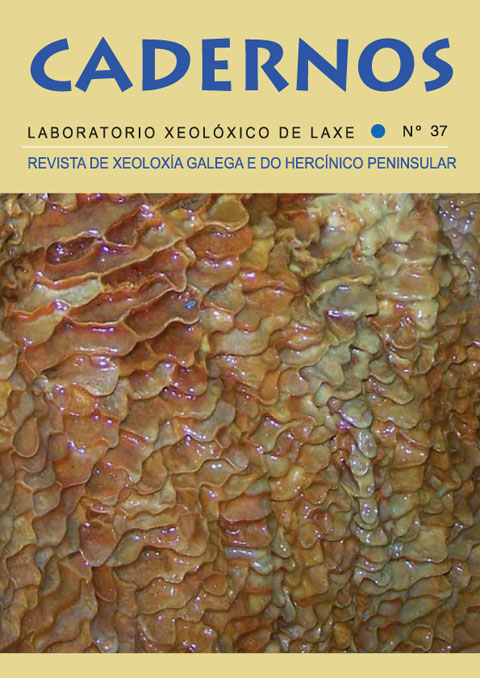TL estimation of ages of pottery fragments recovered from granite caves in the NW coast of Spain
Main Article Content
Abstract
Granite caves and cavities are geomorphological environments associated with underground water flows with a strong turbulent regime linked to seasonality. Though not much studied, they have a great sedimentary and geomorphological interest but sometimes also archaeological because remains of human activity (mainly lithic industry and pottery). Pottery remains appear either exposed or buried and may be characterised mineralogically and dated by thermoluminescence (TL). Water dynamics justifies erosion and fragmentation of ceramic remains which appear broken and spread inside the cavities. This fact hinders their dating due to the small size of the fragments and the disappearance of the original sedimentary context, which does not allow the calculation of part of the received annual radiation dose. In this work, the results from the dating and the estimation of ages of different ceramic fragments of several granite caves of Galicia are presented. The obtained ages go from Medieval (1 ka BP) to Roman or pre-Roman (2 ka BP), Chalcolithic (6 ka BP) and even the beginning of the Neolithic (7 ka BP).
Keywords:
Downloads
Article Details
References
Adamiec, G., Aitken, M. (1998). Dose-rate conversion factors: Update. Ancient TL. 16:37-50.
Aitken, M. J. (1985). Thermoluminescence Dating; Academic Press: London.
Alday Ruiz, A. (2009). Late Mesolithic and Early Neolithic in the Iberian Peninsula: chronology and phases. Munibe, 60, 157-173.
Bernabéu Aubán, J., Gómez Pérez, O., Molína Balaguer, Ll. and García Borja, P. (2011). La cerámica Neolítica durante el VI Milenio Cal AC en el Mediterráneo central peninsular. SAGVNTVM, Papeles del Laboratorio de Arqueología de Valencia, Extra-12, 153-179.
Blain, S., Bailiff, I. K., Guibert, P.; Bouvier, A. and Baylé, M. (2010). An intercomparison study of luminescence dating protocols and techniques applied to medieval brick samples from Normandy (France). Quaternary Geochronology. 5:311-316.
Dean, R. M, Valente, M. J. and Carvalho, A. F. (2012). The Mesolithic/Neolithic transition on the Costa Vicentina, Portugal. Quaternary International 264, 100-108.
Groba González, X and Méndez Quintas, E. (2008). Human occupations during recent prehistory in the granite caves of the western coast of Galicia. Cadernos do Laboratorio Xeolóxico de Laxe. 33:115-126.
Guibert, P., Bechtel, F., Shvoerer, M., Müller, P. and Balescu, S. A. (1998). A new method for gamma dose-rate estimation of heterogeneous media in TL dating. Radiation Measurements. 29:561-572.
Huntley, D. J. and Lamothe, M. (2001). Ubiquity of anomalous fading in K-feldspars and the measurement and correction for it in optical dating. Canadian Journal of Earth Sciences. 38:1093-1106.
Prescott, J. R. and Hutton, J. T. (1994). Cosmic ray contributions to dose rates for luminescence and ESR dating: large depths and long-term time variations. Radiation Measurements, vol. 23, No 2-3, 497-500.
Twidale, C. R. and Vidal Romaní, J. R. (2005). Landforms and Geology of Granite Terrains; Balkema: London, 2005.
Vidal Romaní, J. R., Sanjurjo, Sánchez, J., Grandal D’anglade, A., Vaqueiro Rodríguez, M. and Fernández Mosquera, D. (2010). Geocaracterización de yacimientos arqueológicos en medio sedimentario: cronología absoluta y relativa. Monografías, 4. Museo de Prehistoria e Arqueoloxía de Vilalba. pp. 7-19.
Zilhao, J. (2001). Radiocarbon evidence for maritime Pioneer colonization at the origins of farming in west Mediterranean Europe. PNAS, 98 (24), 14180-14185.
Zimmerman, A. (2012). Cultural cycles in Central Europe during the Holocene. Quaternary International 274, 251-258.



